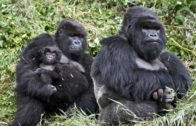
Interesting Facts about Gorillas
- Gorillas are our closest relatives. They share 98% of our genome.
- American zoologist George B. Schaller was the first scientist to study and observed gorillas. He published his findings in his book “The Mountain Gorilla: Ecology and Behavior”
Taxonomy
- Kingdom: Animalia
- Phylum: Chordata
- Class: Mammalia
- Order Primates
- Suborder: Haplorhini
- Family: Hominidae
- Genus: Gorilla
- Species: Gorilla beringei
- Subspecies: Gorilla beringei beringei
o
o
Name
- Common name: Mountain Gorilla.
- Scientific Name: Gorilla beringei beringei
Population and Conservation Status
- There is a combined total of 680 Mountain Gorillas in its two isolated Virunga and Bwindi populations.
- The species is considered “Critically Endangered” by the IUCN Red List of Threatened Species.
- Its population has been severely affected by human activity as their habitat has been gradually destroyed or degraded by mining, agriculture and poaching, forcing mountain gorillas to retreat deep into the mountains.
- Its population reduction during a 60 year period, from 1970 to 2030 is expected to exceed more than 50% and this trend is not easily reversible.
- The key conservation strategy is tourism. However there is an increasing concern of infectious disease transmission among Mountain Gorillas, people, domestic animals and other wild animals. Its population is fully dependent on conservation efforts.
- The Mountain Gorilla is listed under Class A of the African Convention and Appendix I of CITES.
Distribution
- The Mountain Gorilla is a subspecies of the eastern species of gorilla. It is found in two isolated populations.
- One population is found in the 330 km2 Bwindi Impenetrable National Park in southwestern Uganda. The other in the Virunga Volcanoes region of Rwanda, Uganda and Democratic Republic of Congo in an area of 440 km2. Both areas are protected by their respective governments and NGOs.
Habitat
- The Mountain Gorillas of Bwindi live at altitudes of 1,100 to 2,400 meters above sea level in the forest with dense vegetation.
- The Virunga Volcano population live at higher altitudes ranging from 1,500 up to 4,000 meters. This range includes a wider vegetation habitat from bamboo forest to sub-alpine zones with freezing temperatures and very little food to forage on.
Physical Features
- Gorillas are the largest primate. They have long arms, muscular bodies an short legs. Their heads are large and have long canine teeth. Mountain Gorillas differ from other gorillas in that they are larger, have longer and thicker hair, larger jaws and teeth and shorter arms.
- Their coats are thicker and range from bluish black to brownish grey. Its thicker coat allows them to survive in freezing temperatures.
- Males develop a silver or grey patch of hair in their backs and are known as silverbacks.
Size and Weight
- Males have an average weight of 430 lb (195 kg) and an average height of 59 in (1.50 m).
- Females weight 220 lb (100 kg) on average and are 51 in (1.30 m) tall.
Behavior
- The main social unit is an alpha male with a number of females and their offspring, groups have up to 30 individuals. The dominant male or alpha male is visibly larger and stronger than other members in the group.
- The leader organizes all the activities of the group in a home range of about 0.75 to 16 sq miles (2 to 40 sq km). Gorillas are not territorial but will defend the members of their group.
- Females will leave their mothers at around 8 years and start a new group with a lone male.
- Males leave at around 11 years of age and are usually solitary until they form their own group.
- Sometimes conflict arises when a lone male tries to contact the females in the group or attack the young ones. The alpha male displays his physical power by pounding his chest while making loud sounds.
- Gorillas are diurnal animals, they are more active between 6 am to 6 pm. Most of their time is spent eating,
- They build nests to sleep. Nests are often made from straw or leaves and are built on the ground, trees or slopes.
- They use vocalizations to communicate. They also use body language and facial expressions.
- Males emit a strong odor when stressed.
- Gorillas are herbivores. They eat leaves, roots, wood, stems, fruits. They also eat insects. Adult males can eat up to 75 lb (34 kg) of vegetation a day and adult females up to 40 lb (18 kg).
Reproduction
- Gorillas are poygynous, the alfa male in each group has exclusive access to all the females in his group.
- Males reach sexual maturity well after their 15th year, while females reach reproductive maturity at 10 years old. Mating behavior is initiated by the female. They reproduce at any time of the year.
- Females will have 2 to 6 offspring over a 40 year period. Males will father from 10 to 20 over an average of 50 years.
- Gestation lasts 8.5 months. In most cases a single young is born, in rare cases a female gorilla will give birth to twins.
- Nursing lasts until the young is three to four years old. They stay in the maternal group until they reach reproductive maturiry.
Life expectancy
- Life expectancy for the Mountain Gorilla is 55 years.
Predators
- Gorillas are large animals and have no natural predators other than men.
Resources and Further Research
- ITIS Report – Gorilla beringei beringei
- IUNC Red List of Threatened Species – Gorilla beringei beringei
- African Convention on the Conservation of Nature and Natural Resources
- Appendix I CITES
- University of Michigan Museum of Zoology – Gorilla beringei
- The Animal Aging and Longevity Database
- WWF – Virunga: Protecting Africa’s oldest national park
- Science Direct – Possible tool use in Mountain Gorillas
- National Geographic – The Mountain Gorillas of Africa by George Schaller
